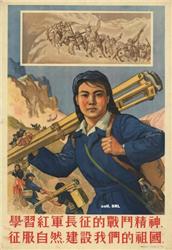
Changes under Mao - I: Industry 1949-56
Summary
Mao inherited a country which was ruined by years of war. Not only was China economically backward, it did not have the human expertise or the government institutions to drive progress forward. Mao himself had no experience of industry or economic know-how.
At first, therefore, Mao impemented his new Communist society cautiously, relying on the Soviet Union for advice, expertise and money. The results were generally positive, but progress was not big enough or fast enough.
Links:
The following websites will help you complete the task:
The First 5-Yr Plan:
• History Learning Site
The nature of Chinese Communism
a. Mao Zedong
The sole, unquestioned, absolute leader
b. One Party State
The Politburo – the ruling group of 12-24 men – was selected from the Central Committee of the CCP, which was elected from the National Party Congress
c. ‘Mao Zedong Thought’
The thoughts of Chairman Mao dominated the party – e.g. ‘Political power grows out of the barrel of a gun’
d. Peasants
Unlike Soviet communism, which said that the Revolution would be made by the proletariat in the towns, the CCP looked to the peasants in the countryside
e. Cadres
The activists of the CCP
Why did Mao want to change China?
a. Agricultural shortages
The war had led to famine and malnutrition, and Mao wanted to end this; also, agricultural crops could be exported to raise foreign currency
b. Industrial weaknesses
Mao did not understand the economy or how industry grew – hence his failed schemes – but he realised that China was industrially backward and needed to grow to become a superpower
c. The Soviet Union
In the early years of the PRC, Mao looked to the USSR as a model, and as a source of help
d. National Resources Committee
The GMD had already begun to stimulate economic growth by setting up an NRC in the 1930s, which directed investment into industry.
e. Peasant capitalism
Mao always believed that the peasants were naturally capitalist, not communist, and he wanted to force them to be communist
The first Five-Year Plan, 1952-6: facts
a. The Yuan
Inflation was controlled by introducing a new currency, the yuan, and by raising taxes on the rich (which reduced the government deficit)
b. Treaty of Friendship, 1949
In December 1949, Mao signed the Treaty of Friendship, Alliance and Mutual Assistance with the USSR; the Soviets sent experts, aid and loans
c. Coal, steel and oil
The output of coal doubled, that of iron and oil tripled
d. Urbanisation
The number of people living in towns almost doubled
Some high-profile projects were also undertaken, such as the road and rail bridge over the Yangzi River at Nanking
The first Five-Year Plan: successes and failures
a. Success – inflation stopped
Inflation was brought under control; people began to use money again, and economic confidence increased
b. Success – economic growth
The economy grew 9% overall; especially, the economy began to rebalance towards industry – peasants began to move into the towns
c. Success – bicycles
1.2million bicycles were produced, though fewer cars – this fitted with a communist, egalitarian ideology
d. Failure – Soviet Aid
In the event, Soviet Aid was a setback, not a help
e. Failure – Speed of Growth
The speed of growth was not fast enough for Mao Zedong, who wanted a Great Leap Forward
Soviet Aid, 1949-60: successes and failures
a. An insult to China
Even the Soviet leader Khrushchev described the Treaty of Friendship as ‘an insult to China … exploiting China’
b. $300million loans and aid
95% of the Soviet money was in the form of loans, at a high rate of interest, plus the PRC was forced to send a substantial portion of its bullion reserves to the USSR;
c. 20,000 experts
The USSR did not supply its 20,000 economic experts free; the PRC had to pay for them. Also Soviet ‘experts’ did not give independent advice, they imposed Soviet ideology … some of their advice (e.g. Lysenkoism) was rubbish
d. 200 construction projects
Including Tiananmen Square – many of Beijing’s ancient houses and structures were pulled down and replaced by Soviet Realism concrete eyesores
e. Relations with the USSR
Realisation that they had been exploited was one of the reasons behind the Sino-Soviet split in 1960
Task
Study this poster and write answers to the questions which follow:
Chinese government propaganda poster, 1953

The text reads: 'Study the battle spirit of the Red Army during the Long March, conquer nature, build up our nation'.
What does this poster tell us about the First Five-Year Plan?
Why did Mao introduce the First Five-Year Plan?
How successful were Mao's attempts to reform Chinese industry, 1949-56?